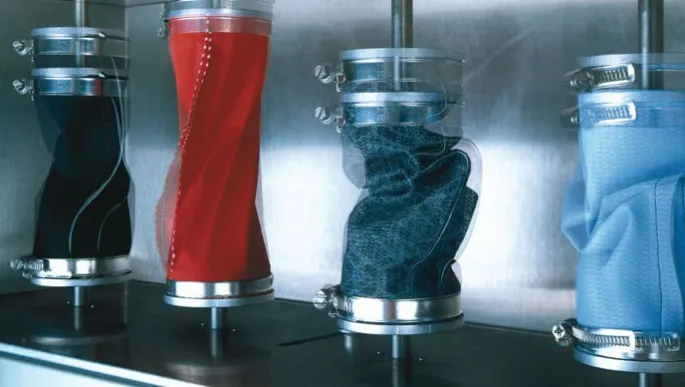Material Tech: The revolution of fabrics in backpacks.
Backpacks are subjected to enormous physical stress throughout their lifespan. When designing new gear, we ensure that the choice of materials is perfectly suited to the intended use. Exploring the possibilities of each fabric is not only exciting work; it guarantees that every backpack performs as promised, even in the most extreme conditions.
OUR FAVORITE FABRICS AND NEW TRENDS
X-PAC®
Developed by Dimension-Polyant , this multi-layer laminate combines nylon , polyester and a cross-shaped X-PLY™ layer that offers structural rigidity, abrasion resistance and high water resistance.
Lightweight, technical and very durable, it has become the standard in ultralight backpacks and adventure cycling.

CORDURA®
A legendary brand in the outdoor world. More than just a material, it's a quality certification awarded by Invista , guaranteeing high abrasion resistance, durability, and a soft feel.
Ideal for backpacks used intensively, in urban or military settings. Its "technical canvas" appearance offers a robust and natural aesthetic.

DYNEEMA®, SPECTRA® and UHMWPE
Ultra-high molecular weight polyethylene (UHMWPE) is one of the strongest fibers in the world, with a strength-to-weight ratio superior to steel.
Dyneema® or Spectra® fabrics incorporate it into their structure, resulting in extremely lightweight backpacks that are tear-resistant and highly durable against UV rays and humidity.
More and more mountain brands are incorporating it into minimalist or technical mountaineering backpacks.

ECOPAK™ (Next-Gen X-PAC)
The sustainable evolution of X-Pac®. Made from 100% recycled rPET polyester, without polyurethanes or PVC, and with PFAS-free waterproof lamination.
It offers the same performance as its predecessor, but with an 80% smaller environmental footprint . It's the new favorite among brands committed to sustainability.

GRAPHENE-INFUSED FABRIC
One of the most revolutionary innovations. The incorporation of graphene into the fabric reinforces mechanical resistance, improves thermal conductivity, and offers natural antibacterial properties.
Although still in the expansion phase, it is already being applied in high-end technical backpacks.

RECYCLED NYLON AND BIO-NYLON
Recycled nylons (such as ECONYL® ) are made from fishing nets and industrial waste. They maintain the same performance as virgin nylon but drastically reduce environmental impact.
Bio-nylon (biologically based, derived from vegetable oils) is another emerging trend, combining lightness, elasticity and sustainability.

VINYL-COATED POLYESTER / TARPAULIN
Also known as truck tarp , it is an extremely strong and flexible material, ideal for high-wear areas or structural reinforcements.
Its glossy finish and firm feel make it perfect for flaps, bases, or bottoms of urban backpacks. However, its considerable weight limits its use on lightweight backpacks.

TECHNICAL PROPERTIES TO CONSIDER IN A GOOD DESIGN.
The materials and fabrics used in the various designs have very diverse mechanical properties, and all are subjected to different tests. There are many ways to measure the properties of a textile, but below we will focus on the key factors that most influence performance.
WEIGHT
The weight of the fabric is one of the first aspects we evaluate. It is measured in grams per square meter (g/m²) or ounces per square yard (oz/yd²).
A lighter material can make a big difference to the user experience, especially in technical applications such as trekking, climbing, or trail running.
*Note on “Denier”: The term denier (D) is commonly used to refer to the thickness of the yarn used in weaving (e.g., 1000D or 420D). However, a higher number does not always mean greater strength: the type of fiber, the weave, and the finish can have a greater influence than the denier on the final performance.
A well-woven 400D can outperform a coarser 600D in durability.


ABRASION RESISTANCE
Abrasion resistance measures how much friction a fabric can withstand before deteriorating. It is evaluated through controlled friction tests that determine the number of cycles before breakage.
We always seek an optimal balance between weight and resistance: lightweight materials but with outstanding performance against wear.

ELONGATION
Elongation indicates how much the tissue can stretch before it breaks.
In most cases, we prefer materials with low elasticity to maintain the backpack's shape and stability. However, in side pockets or elastic panels, a controlled high elongation can be beneficial.

TEAR RESISTANCE
This parameter measures the force required for the fabric to break or propagate a tear.
Ripstop fabrics with reinforced grid threads stop tears before they spread, which is essential in mountain or expedition backpacks.

WATER RESISTANCE
Waterproofing is tested under water pressure and exposure time.
Most technical fabrics include a polyurethane (PU) lamination or polyester coating , which prevents water penetration without compromising flexibility. Premium backpacks already use TPU membranes or ECOPAK™ film , which are more durable and PVC-free.

In summary
Textile technology is transforming backpack design. It's no longer just about strength or weight, but about balancing performance, aesthetics, and sustainability .
New materials, from recycled ECOPAK™ to Graphene and Dyneema®, usher in a new era in outdoor manufacturing, where innovation meets respect for the planet.
0 comments